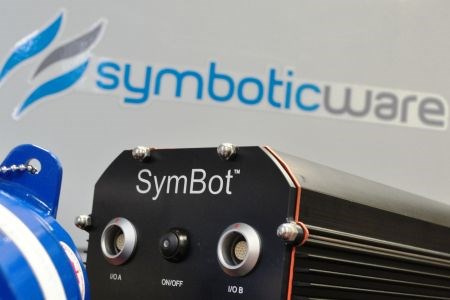The safety of workers in underground mining operations stands to improve through new wireless infrastructure technology being developed by Sudbury-based Symboticware Incorporated.
In conjunction with local post-secondary institutions and experts from around the world, Symboticware is working to build stronger and broader connectivity in these harsh environments.
Through its Open Sensor Network project, the company is hoping those who work in and run mines will have much more timely communication of crucial information, whether it’s engine levels or air flow, contaminant levels or air temperature.
“It’s not about replacing infrastructure, but adding onto it,” says Bora Ugurgel, marketing and sales manager for Symboticware.
“What we found is that in new drifts, there’s no (network) communication, so this might be a way around it.”
Still in the design phase, this project is based on the company’s SymBot platform, a small rugged industrial computer that collects data from mobile mining equipment. That data is transmitted whenever the vehicle passes through the mine’s wireless network.
However, there are many areas in underground mines where the wireless network doesn’t reach, such as where new development is taking place, and it can take time for a vehicle to reach a hotspot.
Similarly, Symbot portable air monitoring stations are often used far from such hotspots, and require manual data collection.
To resolve these issues, Symboticware is looking to use small, inexpensive radio tags to extend the wireless network, laying them out from the wireless-capable areas through to the “dead zones.”
Though this provides lower bandwidth than actual wireless hotspots, it allows for alerts or crucial information related to safety, maintenance, or operational efficiency to be transmitted between mine staff.
“You might be in the working area, and there’s some alert you want to be able to send through and not have that huge delay to get to the (wireless) hotspot,” says Lorrie Fava, Symboticware’s manager of research and development. “That’s where this comes in.”
The tag system will also have the ability to re-organize itself, meaning that if one tag in the wireless networking chain is damaged or falls, others will pick up the virtual slack.
Applied research on this technology is being done with $100,000 from the Ottawa-based Precarn Incorporated, a non-profit organization supporting pre-commercial development of leading-edge technologies. Contributions from the federal Industrial Research Assistance Program, to the tune of $47,650, are also in hand.
As this funding is focused on projects that are on the cusp of commercialization, Symboticware staff has a relatively short window to see their efforts through. Having begun in August, work is expected to wrap up by March 2011.
This is the same general end date for some of the other collaborative research projects the company has a hand in. In collaboration with the Centre for Excellence in Mining (CEMI), Vale, Xstrata Nickel and some industrial partners, Symboticware is working on efforts relating to underground mine ventilation and other practical uses of wireless networking technology.
The work being done in these other projects will feed directly in its open sensor network research.
To bolster their efforts, staff is drawing expertise from Dr. Gareth Kennedy, from the United Kingdom’s University of Exeter. In October, Kennedy travelled to Sudbury to help provide insight into some of his studies in how certain types of wireless network signals will propagate, and how far apart devices can be.
Once parts have been sourced and the devices manufactured, real-world testing of the product will take place at one of Vale’s properties, though the exact location has yet to be determined.
Another major partner in this project is Collège Boréal, where technicians and up to 20 students from its industrial electrician program will begin testing in the coming weeks.
This will put the device through the quality control and quality assurance process, leading to the development of detailed documentation for automated reproduction of the unit. It is expected to wrap up by December.
This sort of work would require costly equipment purchases for Symboticware, which would be less than practical for a one-time use. Tapping into Boréal’s equipment and expertise instead represents the ideal option, says Bugurgel.
This recognition of the school’s resources represents a great deal of effort on the part of administration to seek out local industry and respond directly to their needs, says academic vice-president Daniel Giroux.
“The role of community colleges is working with the community,” says Giroux. “For us to be able to give back not only to the community but to an SME is a great example of how you can give a chance to students and faculty to be a part of innovationand industry. The best part is that it’s applied research, not just theoretical; it’s hands-on and it’s something that will see results in the short-term.”
This partnership also represents the transition Boréal is making towards more technologically oriented research efforts, says Giroux. To date, environmental research projects have been a major focus for Collège Boréal, which has helped out with projects with a wide variety of industrial and government partners.
Last year, the school struck a partnership with Xstrata Nickel to build additional phases for a new biodiversity research centre.




